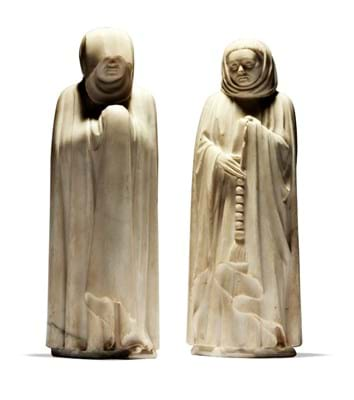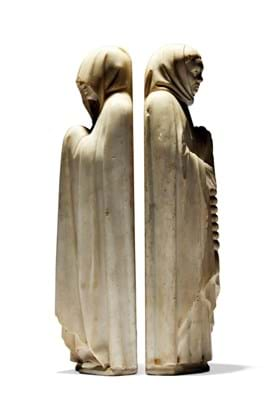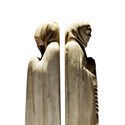The marble figures which measure approximately 14½ in (37.5cm) in height, originally formed part of a processional frieze of 40 draped mourners or pleurants that surrounded the sides of the duc’s tomb and were surmounted by a life size carving of his recumbent figure.
The duc was a great patron of the arts best known today for commissioning the famous illuminated manuscript known at the Très Riches Heures du duc de Berry. He also commissioned his own tomb for the Sainte Chapelle of the Ducal palace in Bourges and appointed the sculptor Jean de Cambrai to build it.
De Cambrai managed to complete the life-size statue and five mourners before the Duc died in 1416 and construction was halted. The carving of the remaining figures was then taken up by two other sculptors, Etienne Bobillet and Paul Mosselmann, and the tomb completed around 1459.
The tomb remained in the Chapel at Bourges until it was vandalised during the French Revolution and the figures destroyed or dispersed. Only the recumbent figure and slab remain, now preserved in Bourges Cathedral.
Unbroken Provenance
So far 29 of the 40 mourners have been tracked down. Christie’s duo are two of the five completed by de Cambrai and have been in the same family since 1807 when they entered the collection of Pierre-Henri Péan de Saint-Gilles.
Just over two years ago Christie’s sold a pair of alabaster figures from the second period of carving on the tomb that had been consigned from the same source. These realised €3.5m (then £3.07m) giving some kind of ball park figure for the estimate on this marble duo which were guided at €4.5-5m.
The Louvre exercised its right of pre-emption to secure these figures stepping in to claim them at the fall of the hammer at the June 15 auction.
The museum also pre-empted a mid 15th century Limoges enamel plaque painted by Jean II Penicaud with a figural scene representing an allegory of Dialectic which realised a hammer price of €85,000 (£70,835).









